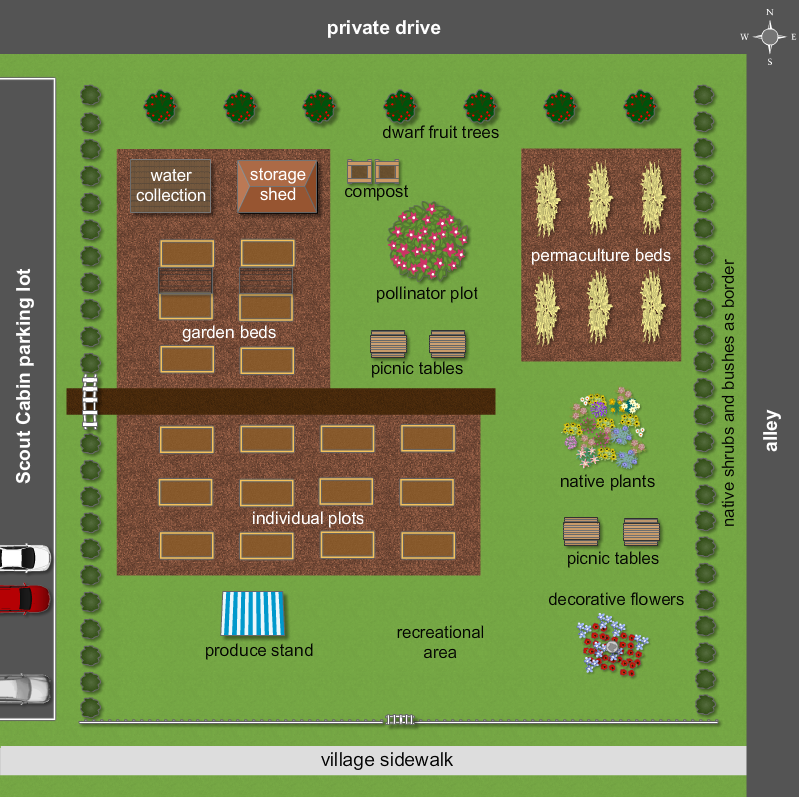Vision
Our vision is to provide opportunities for community involvement through sustainable growth and beauty in our community garden.
Strategy
Our strategy in achieving this vision is to create a welcoming outdoor community place, with a focus on community involvement.
We teach adults and children how to care for a garden as well as make healthy food choices.
We provide a place of relaxation and rejuvenation.
We take pride in what is planted, tended, and picked.
We establish sustainable gardening techniques.
We promote beauty and growth for our village.
Values
The core values, which are the driving force of our actions and guide us toward achieving our vision are honesty, inclusiveness, innovation, sustainability, and a focus on community.
Our current layout design for the community garden features elements which will not be realized during the first season. This layout design is a collection of many of our short-term and long-term goals for the garden.
We welcome community input on the garden at every stage in the process. If you have suggestions, requests, ideas, or concerns, please contact us. We would love to hear from you.
FAQs
-
The community garden is located at 200 West Williams Street in Archbold, right next to the scout cabin at Ruihley Park.
Our mailing address is:
Archbold Community Garden
PO Box 81
Archbold, OH 43502 -
Events will be held at the scout cabin, outside at the garden, or at other locations in the community. Please refer to each individual event description for the exact location.
-
Visitors and volunteers may use the Scout Cabin parking lot for loading and unloading, but need to utilize the public parking at Ruihley Park for parking. Visitors and volunteers may not use the Scout Cabin parking lot if there is an ongoing event at the cabin. Visitors and volunteers may not park in the alley to the east of the garden, on the street to the south of the garden, or in the private drive to the north of the garden.
Archbold Community Garden does not own nor lease the Scout Cabin parking lot and is asking visitors and volunteers to be respectful of these rules.
-
To get involved with the garden, you can donate money, resources, or volunteer time. You can contribute yourself or on behalf of your business as a sponsor. Please refer to our “Get Involved” or “Donate” pages.
-
The community garden is not offering individual plots for the 2023 season. We plan to make individual plots available in the near future. This year, you can participate in cooperative gardening, which is a group effort by all of the volunteers.
-
Please refer to our layout design for current ideas about placement of structures on the property. This layout is not final and may be changed as necessary to comply with zoning requirements and community guidance. If you have any input on the placement of structures, please contact us with your ideas and/or concerns.
-
One of the top goals of the community garden is to bring beauty to the Village of Archbold. We ensure that our plans and visions are in line with expectations from the community and immediate neighbors. If you have any input on upcoming projects, please contact us with your ideas and/or concerns.
-
Part of the property will be surrounded by a natural border consisting of perennial plants such as dwarf fruit trees, native bushes, grasses, and other plants. This kind of natural border will bring more beauty to the garden and provide habitats for wildlife. Other parts of the property will be enclosed by a fence. Safety, visibility, and beauty are among our top concerns for any kind of fence or natural border.
-
The water collection will be a lean-to shed. Its roof will collect rainwater, which will be stored in water tanks underneath. Other water collection systems may be put in place in the future, if the need arises.
-
Security lights will be installed in the future, as the garden grows. These lights will be low to the ground and not disturbing to any surrounding residents.
-
In the first year, there will be some mulch paths as needed. In the future, we plan to install more permanent paths on the property, to make the garden more accessible.
-
Various composting methods, such as in-ground composting make the compost material inaccessible to pests and contain the smell. Traditional composting, such as a compost pile or a larger compost bin, don’t attract any pests as long as only plant waste is composted. Compost piles and bins also don’t smell if the right ratio of brown materials (straw, sawdust, leaf litter, etc.) and green materials (kitchen scraps, vegetables and fruits, fresh plant materials) are combined. This ratio is usually 2:1 browns:greens by weight. If the materials are well-mixed and the compost pile is turned and aerated regularly, the carbon in the brown materials neutralize the odors from the nitrogen in the green materials.
-
At the community garden, we will employ a variety of gardening methods, ranging from more traditional gardening in raised garden beds to permaculture methods, such as deep mulch gardening or Hügelkultur. Educational signage on site and information on our website will be available as we begin using those methods.
-
Using permaculture principles, we will integrate our garden with the wildlife in the area. This includes squirrels and other critters. We may not be able to keep them out of our garden entirely, but they can be deterred using organic and non-chemical substances as well as companion planting strategies.
-
A pollinator plot consists of native flowers and other flowering plants, which support local bees and other pollinating insects. These insects are an important part of the ecosystem of the garden and the surrounding area.

